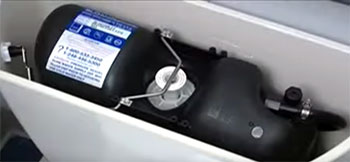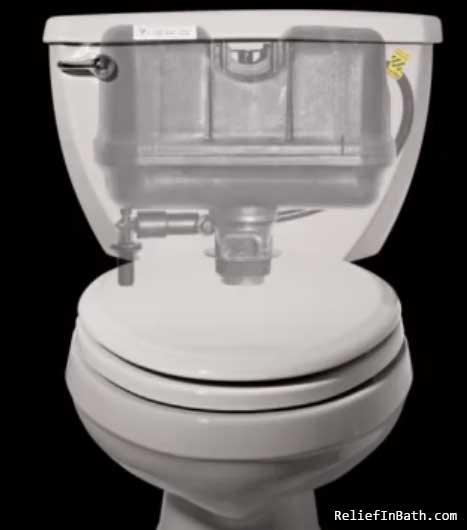Flushmate is a great solution to a lot of toilets that constantly use a lot of water. If you want to keep the water consumption limited in your toilet, then Flushmate can be a handy option to pick.
It uses pressure-assist technology to keep the water consumption in check.
However, this is not something that comes without issues either. The system has its issues that you have to get through as well.
Flushmate leaking at the seam seems to be one of the most common issues people tend to face. Although, you don’t need to worry too much.
I am here to help you fix the leaking issue that you may face with your Flushmate system. So, whether you are already using the system or you are planning to get it, knowing this can help you a lot in the way.
Let’s get started with it.
What is a Flushmate System?
Flushmate is a type of pressure-assisted flushing system used in many toilets. It uses compressed air to provide a powerful flush that efficiently clears waste from the bowl in just one flush.

Flushmate systems consist of an inner tank sealed inside the outer ceramic tank. The inner tank holds both water and pressurized air. When the toilet is flushed, the pressurized air pushes water from the inner tank into the toilet bowl with great force. This creates a strong siphon effect that cleans the bowl thoroughly.
The advantage of a Flushmate system is that it provides a robust flush using only 1.6 gallons of water, compared to 3-5 gallons used by gravity-based toilets. This makes Flushmate an environmentally friendly option. The compressed air also helps reduce clogs.
However, Flushmate models have also been plagued by issues of the inner tank leaking at the seam. This can cause water damage and other major problems.
Why Does It Leak At Seam?

Typically, all the other leaks that happen in a Flushmate toilet are pretty usual with any other toilet system.
However, when your Flushmate is leaking at the seam, this is mostly due to two reasons.
Let’s get through them, and then we will talk about the solution to the problem.
- Manufacturing Defects
The first reason is that there are several manufacturing issues, specifically with the Flushmate 503 series.
Because of this reason, they had to be recalled by the manufacturers.
This defect would cause the system to burst at the vessel weld seam due to too much-stored pressure.
The pressure is strong enough to lift your toilet tank lid and completely shatter the tank.
As you can pretty much tell, the problem is a nuisance and too risky to be around.
- External Damages
Any external damage to the seam of the Flushmate toilet can also result in this leaking issue. It’s a very obvious cause of the leak as well.
When the seam receives any kind of damage, it will cause some leaks here and there at the seam. This results from the vessel containing all the pressure and releasing it all at once.
These damages can either cause while shipping or while the toilet system is installed in your bathroom.
- It Gets Too Much Pressure
Another reason you may face a leak at the seam is that it has been receiving too much air pressure.
When the Flushmate system runs on for a long time and puts out a lot of air pressure, it eventually leads to lead. At least that’s what happened with one of the products from the company.
This kind of air pressure takes place over a lot of years and then develops that kind of leak at the seam. It doesn’t happen suddenly. So, no matter how old your system is, always consider this to be a reason for the leak.
Usually, these are the causes for leaking at the seam of your Flushmate toilet system. Other than that, there aren’t many reasons to cause a leak at the seam.
There may be leaking issues in other areas, but you shouldn’t be bothered by leaking at the seam.
Dangers of a Leaking Flushmate
A leaking Flushmate system can cause a wide range of troubles. Here are some of the biggest risks:
- Water damage – Water leaking from the tank can saturate surrounding flooring and subfloor. This can lead to water stains, buckling laminate or wood floors, mold growth, and major repairs.
- Rotting toilet base – Leaks around the toilet base can rot the floor flange and subfloor if left unaddressed. This weakens the stability of the toilet.
- Slip hazards – Water pooling on the bathroom floor creates a dangerous slip risk. This is especially hazardous for seniors or small children.
- Property damage – If the leak is significant or goes unnoticed, water can spread under walls and cause damage throughout the home. Electrical, walls, and cabinets can be affected.
- Toilet unusable – A leaking inner tank will eventually fail to flush properly. You may be left without an operating toilet until repairs are made.
- High water bills – Leaking water inflates your water usage and monthly costs. A very slow leak may take months to reflect abnormally on your bill.
- Air quality issues – The leak allows compressed air to escape from the system. This can reduce air quality in the bathroom.
The extent of the damage depends on the size and duration of the leak. Small leaks found quickly may require just toilet replacement. Major leaks can mean thousands in repairs, replacements, and restoration to your home.
What To Do To Fix The Leak At Seam?

Here is the tricky part: fixing or repairing this issue can be very risky. First of all, these tanks usually come with air pressure inside.
So, when you start working on them or try to seal the leak of the seam, you may even hurt yourself.
Secondly, there are no bonding agents out there that can hold out the leak for a long time. It will be back to its original state by 3 or 4 flush cycles.
The best solution in this scenario is to replace the whole system. You can either do it yourself or opt for a plumbing service. Let’s check out the steps of replacing a Flushmate toilet.
- Firstly, you have to turn off the water supply. And then flush your toilet so that all the internal pressure from it gets relieved.
- Then, you have to disconnect the water supply line of your flushmate from the shank. After that, remove the China tank from the bowl.
- Now, you have to remove the plastic locknut on the shank, the gasket, remove the tank locknut. This will release the flushmate vessel for removal.
- Next up, you have to take up your replacement tank. Make sure to use the groove gasket if it has any.
- Then, you have to install your flushmate vessel into the China tank and reverse everything you did till now.
- You have to install the tank locknut, the gasket on the bottom, and the shank locknut.
- Then, you can install the China tank back onto the toilet bowl.
- Reconnect the water supply line. Then, turn on the water to see if any leaks are happening or not.
Now, this is the only solution you are left with when there is a leak at the seam of a Flushmate toilet.
However, you should keep in mind that there is a lifetime warranty on Flushmate toilet systems, especially if your toilet is reported from 1997 to 2008 productions.
So, you have to make sure that you are taking advantage of the lifetime warranty. Don’t just go off and buy the replacement vessel. Make sure to contact the Flushmate customer support and let them know about your problem.
Also, when opting for plumbing service, you have to make sure that you choose a service capable of fixing the problem. Since Flushmate uses air pressure for flushing the toilet, it’s hard to deal with the whole system.
How To Prevent Future Leaks
To avoid needing future repairs from a leaking Flushmate system, consider these tips:
- Inspect regularly – Periodically inspect around the toilet base and inside the tank for any signs of moisture or dampness. Catching leaks early is key.
- Replace seals/gaskets – The seals around the tank may wear out over time. Have a plumber replace any cracked or dried out gaskets.
- Use in-tank cleaner tablets – Drop-in cleaners help prevent mineral scale that can corrode seals. Never use in-bowl cleaners in a Flushmate.
- Install a new toilet – When remodeling or replacing an aging toilet, install a new high efficiency model without a pressure-assist tank.
- Use a water leak detector – Smart home water leak detectors like Flume can identify leaks at the first sign of trouble and alert your phone.
- Maintain water pressure – Install a pressure regulator if your home’s water pressure exceeds 80 PSI. High pressure strains the tank.
- Avoid harsh chemicals – Bleach, industrial cleaners, and in-bowl toilet tabs can corrode the Flushmate tank over time.
Careful maintenance and inspection along with replacing outdated Flushmate models can help avoid leaks down the road. Consult a plumber at any signs of trouble.
Frequently Asked Questions
Yes, Flushmate systems always have water in the tank along with compressed air. When the toilet is flushed, the pressurized air pushes the water forcefully into the bowl. If there is no water in the tank, this indicates the Flushmate system is malfunctioning.
Yes, pressure assisted toilets like Flushmate are susceptible to leaking just like gravity flush toilets. The pressurized inner tank has plastic seams that can fail over time leading to leaks, especially in older models. Leaks usually start small but can worsen over time.
If the Flushmate system is continuously running water to refill the tank, there are a few possible causes:
The flush valve is worn out or minerals have built up, preventing it from sealing fully. This allows water to continuously trickle into the tank.
There is a leak in the pressurized tank allowing water or air to escape. The system keeps refilling to compensate.
The water inlet fill valve is faulty and not shutting off completely.
The refill tube inside the tank has come loose and is pointed incorrectly.
A plumber can diagnose the specific issue and repair or replace any malfunctioning components.
Several Flushmate models have been recalled over the years, generally due to issues with the tank leaking under pressure. Flushmate issued voluntary recalls and provided replacements for the Series 503 through the 501-UA affected models. Check the Flushmate website with your model number to see if it was part of a recall. If so, replacement parts may still be available.
However, many leaky Flushmate systems are older models that are no longer covered under warranty. The manufacturer is unlikely to provide support. In these cases, a full toilet replacement is recommended.
Conclusion
To sum up, Flushmate is an excellent solution for your toilet water consumption. However, Flushmate leaking at the seam can be an annoying and unsafe issue to deal with.
The only solution you are left with here is the replacement of the toilet. Because trying to fix the issue is not worth the effort and can get pretty risky as well.
